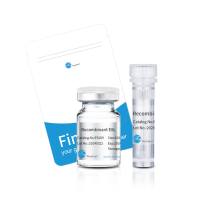Analysis of DNA‐Protein Interactions Using Proteins Synthesized In Vitro from Cloned Genes
互联网
- Abstract
- Table of Contents
- Materials
- Literature Cited
Abstract
To detect DNA binding activity, radiolabeled protein is incubated with specific DNA fragments, and protein?DNA complexes are separated from free protein by electrophoresis in native acrylamide gels. Unlike the more conventional mobility shift assay which utilizes 32 P?labeled DNA and unlabeled protein, the assay described here generally utilizes 35 S?labeled protein and unlabeled DNA. Major advantages of this method are that any desired mutant protein can be tested for its DNA?binding properties simply by altering the DNA template, and the subunit structure (e.g., dimer, tetramer) can be determined.
Table of Contents
- Reagents and Solutions
- Commentary
- Literature Cited
Materials
Basic Protocol 1:
Materials
|
Figures
Videos
Literature Cited
| Literature Cited | |
| Hope, I.A. and Struhl, K. 1985. GCN4 protein, synthesized in vitro, binds HIS3 regulatory sequences: Implications for general control of amino acid biosynthetic genes in yeast. Cell 43:177‐188. | |
| Hope, I.A. and Struhl, K. 1986. Functional dissection of a eukaryotic transcriptional activator protein, GCN4 of yeast. Cell 46:885‐894. | |
| Hope, I.A. and Struhl, K. 1987. GCN4, a eukaryotic transcriptional activator protein, binds DNA as a dimer. EMBO J. 6:2781‐2784. | |
| Johnson, A.D. and Herskowitz, I. 1985. A repressor (MATα 2 product) and its operator control a set of cell type specific genes in yeast. Cell 42:237‐247. |









